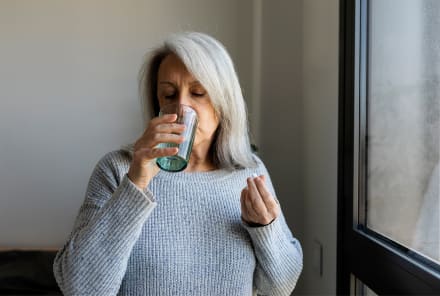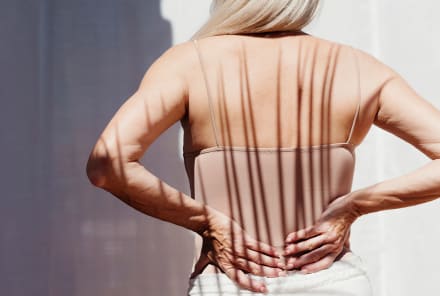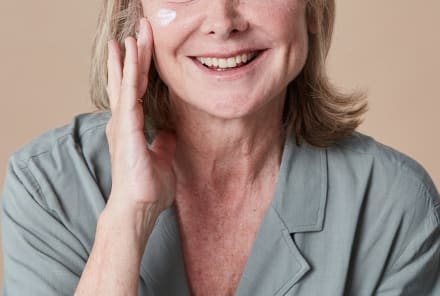Advertisement
Social Prescriptions Are The Future: Here's 5 You Should Know


In America, we’re constantly bombarded with ads for prescription drugs promising to treat anxiety, diabetes, and even dementia. While this Western approach to illness has its place, some countries are trying something new: social prescriptions.
These are referrals from your doctor to engage in community activities like volunteer groups, beginner-friendly sports clubs, or art classes. And guess what? They’re working.
In this episode of the mindbodygreen podcast, we dove deep into the science of social prescriptions and how changing your environment can change your health. Our guest was Julia Hotz, a solutions journalist and author of The Connection Cure, who traveled the globe to explore the power of prescribing social connections, artistic endeavors, and more.
Below is an overview of the pillars of social prescriptions, straight from the podcast episode.
Movement
First, we have movement—but we’re not talking about prescribing a gym membership. For many people, exercise is a difficult habit to build, especially if you don’t enjoy the activity at hand. Be it lifting weights or long-distance running, some workouts can be, well, boring.
That is reason enough to recommend something more engaging and interesting—like sea swimming, for example. When Hotz sat down with Amanda, a woman who cured her depression through sea swimming, she learned that it’s more than just the movement that supports mental health. It’s the cold temperature, the heart-racing action, and the beauty of the open water.
The same goes for cycling, which has been shown to significantly reduce mortality risk1. Like sea swimming, cycling forces you to get outside, get moving, and often connect with other people. You’re pushing yourself out of your comfort zone and into the moment.
Frank, a cyclist Hotz met on her journey to understand social prescriptions, started cycling as an adult after being prescribed a cycling confidence course by his doctor.
The hope of his physician came true: Cycling, an activity Frank had loved as a child, was just what he needed to find the motivation to exercise and, in turn, come off the insulin he was previously relying on to manage his type II diabetes.
The message here is clear: Movement is medicine—but that doesn’t mean you have to force yourself into exercises you hate. Find something that brings you more than just physical fitness—something that brings you awe, joy, community, and passion.
Summary
Nature
We know that getting into nature is good for our mental health, but we don’t often discuss the why behind the benefits of green space, outdoor sports, and nature gazing.
Hotz suggests that nature forces you to be mindful, using sea swimming as an example: “The cold open sea gives you a sense of awe,” she says, adding that, “Awe is the opposite of rumination. It takes us out of our heads and absorbs us in our environment.”
Nature exposure holds great promise for children’s mental health as well, with exciting research on ADHD prevention and treatment. For example, one landmark study of kids with ADHD found just twenty minutes in the park improved their concentration2, with effects on par with taking Ritalin, a common medication prescribed for adolescent ADHD.
Upon stepping into nature, you’re automatically pulled into another space mentally. The difference between this form of distraction and something like social media or television is that you leave feeling more relieved and focused than before. As Hotz puts it, “Nature is one of the only things that can capture our attention without taxing it.”
Nature is one of the only things that can capture our attention without taxing it.
These benefits aren’t just relevant for mental health, either. Research also shows that people who live closer to green space live longer3 and have fewer health complaints—and that’s just the tip of the iceberg in research on nature’s influence on health.
Summary
Community
We can’t discuss longevity without mentioning community. “Strong social connections are your greatest predictor of longevity4, more than IQ, more than income, more than genes,” Hotz says.
Most people would assume that having a friend or two checks the box, but it’s the quality of those relationships that really matters.
“We sort of have our cultural picture of what loneliness is, you know, maybe an older person who's isolated. Actually, loneliness refers to the absence of quality relationships, just as I mean, the cliché is true. You can be lonely in a crowd,” Hotz says.
She adds, “Just as a 400-calorie bag of chips isn't going to satisfy you as much as a 400-calorie, you know, plate of broccoli and turkey, the same is true for relationships.”
This is why so many innovative programs Hotz mentions, like the Culture Vitamins in Denmark, where doctors prescribe lifestyle modifications through group activities, and the dementia farms in Norway5, where adults with dementia work on a farm together, put significant emphasis on social connections.
Even in exercise groups, like Frank’s cycling team or Amanda’s sea swimming group, an element of community and connection multiplies the benefits of exercise endlessly.
Summary
Service
You may be sensing a theme here. All of these healing modalities help you step outside of your mind and into something else—which is where the next topic really shines: service. Whether it’s volunteering at your local animal shelter or food kitchen, or running errands for a loved one, service helps you change your worldview for the better.
Hotz stresses the importance of engaging in some cause that is bigger than yourself. “It's all about taking us out of our own heads and connecting us to the people and environments around us,” she says.
It's all about taking us out of our own heads and connecting us to the people and environments around us.
This is part of the magic that makes Norway’s dementia farm so beneficial for cognitive health. The service tasks that these older adults complete give them a momentary mission, something they can accomplish every single day and feel good about.
Research backs up the health benefits of volunteering, too. For example, a 2020 study conducted in the United Kingdom found those who volunteered reported being more satisfied with their lives6 and rated their overall health as better. Respondents who volunteered for at least one month also reported having better mental health than those who didn’t.
This doesn't have to be a major time consuming activity, either. As the research shows, even one activity a month can make a difference in your mental health and help your community.
Summary
Art
Finally, we have art—perhaps one of the most overlooked forms of therapy, especially for healing trauma.
“It is so deeply stored within us that we can't find the words to describe our trauma sometimes. But art is like that portal. Art is a medium making that a little bit easier,” she says.
For complex trauma, which some people refer to as "Big T trauma," Hotz suggests starting with a regimented art therapy program with trained guides in an attentive one-on-one setting.
Research has shown that art therapy can be an effective treatment for anxiety7 in older women, with effects lasting when checked three months later.
Art therapy has also been shown to be effective in treating adolescent depression8, with higher compliance rates than many other forms of therapy and medication.
The best part? Art therapy comes in many forms—focused individual sessions, group therapy activities, outdoor art therapy, and so on.
When you tie in the portal that is art with an element of belonging and community and add nature exposure on top of that, healing is sure to follow.
Summary
The takeaway
Social prescriptions have the power to heal. From exercise groups to nature exposure to community bonding and art therapy, there are so many different ways to approach healing that deserve more attention, especially in the United States.
To dive deeper into the science behind social prescriptions and how to find the best one for you, tune into the full episode.
You can watch on YouTube or listen in on Apple Podcasts.
8 Sources
- https://www.ncbi.nlm.nih.gov/pmc/articles/PMC10546027/
- https://journals.sagepub.com/doi/10.1177/1087054708323000
- https://www.ncbi.nlm.nih.gov/pmc/articles/PMC5642810/
- https://www.ncbi.nlm.nih.gov/pmc/articles/PMC4725506/
- https://www.sciencedirect.com/science/article/abs/pii/S074301672100022X
- https://link.springer.com/article/10.1007/s10902-020-00242-8
- https://www.ncbi.nlm.nih.gov/pmc/articles/PMC6549595/
- https://www.tandfonline.com/doi/full/10.1080/07421656.2024.2309422#d1e1213
Watch Next
Enjoy some of our favorite clips from classes
Enjoy some of our favorite clips from classes
What Is Meditation?
Mindfulness/Spirituality | Light Watkins
Box Breathing
Mindfulness/Spirituality | Gwen Dittmar
What Breathwork Can Address
Mindfulness/Spirituality | Gwen Dittmar
The 8 Limbs of Yoga - What is Asana?
Yoga | Caley Alyssa
Two Standing Postures to Open Up Tight Hips
Yoga | Caley Alyssa
How Plants Can Optimize Athletic Performance
Nutrition | Rich Roll
What to Eat Before a Workout
Nutrition | Rich Roll
How Ayurveda Helps Us Navigate Modern Life
Nutrition | Sahara Rose
Messages About Love & Relationships
Love & Relationships | Esther Perel
Love Languages
Love & Relationships | Esther Perel
What Is Meditation?
Box Breathing
What Breathwork Can Address
The 8 Limbs of Yoga - What is Asana?
Two Standing Postures to Open Up Tight Hips
How Plants Can Optimize Athletic Performance
What to Eat Before a Workout
How Ayurveda Helps Us Navigate Modern Life
Messages About Love & Relationships
Love Languages
Advertisement

This Supplement May Remarkably Benefit Those With A High Risk Of Alzheimer’s
Molly Knudsen, M.S., RDN

Want To Be Metabolically Healthy? Study Shows An Underutilized Approach
Molly Knudsen, M.S., RDN

Don’t Eat A Lot Of Meat? Make Sure You Take This Supplement Daily
Molly Knudsen, M.S., RDN

Study Reveals 2 Habits That Are Early Signs Of Muscle Loss In Women
Molly Knudsen, M.S., RDN

This Supplement May Remarkably Benefit Those With A High Risk Of Alzheimer’s
Molly Knudsen, M.S., RDN

Want To Be Metabolically Healthy? Study Shows An Underutilized Approach
Molly Knudsen, M.S., RDN

Don’t Eat A Lot Of Meat? Make Sure You Take This Supplement Daily
Molly Knudsen, M.S., RDN

Study Reveals 2 Habits That Are Early Signs Of Muscle Loss In Women
Molly Knudsen, M.S., RDN

This Supplement May Remarkably Benefit Those With A High Risk Of Alzheimer’s
Molly Knudsen, M.S., RDN

Want To Be Metabolically Healthy? Study Shows An Underutilized Approach
Molly Knudsen, M.S., RDN

Don’t Eat A Lot Of Meat? Make Sure You Take This Supplement Daily
Molly Knudsen, M.S., RDN

Study Reveals 2 Habits That Are Early Signs Of Muscle Loss In Women
Molly Knudsen, M.S., RDN

This Supplement May Remarkably Benefit Those With A High Risk Of Alzheimer’s
Molly Knudsen, M.S., RDN

Want To Be Metabolically Healthy? Study Shows An Underutilized Approach
Molly Knudsen, M.S., RDN

Don’t Eat A Lot Of Meat? Make Sure You Take This Supplement Daily
Molly Knudsen, M.S., RDN

Study Reveals 2 Habits That Are Early Signs Of Muscle Loss In Women
Molly Knudsen, M.S., RDN










